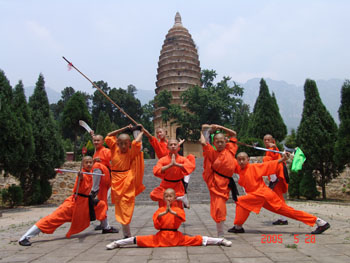It is overland tour to Mt. Wudangshan in Hubei province from Xian. Hubei province is located in mid China connecting many provinces in China by convenient transportation of railway, cruise, and flights......

Kung Fu ( Kungfu, also called China Wushu, or martial arts) could be defined as any of the various Chinese martial arts. Chinese Kung Fu was studied, organized and systematized by the Shaolin monks. Shaolin Kung Fu is known for their many animal styles such as Tiger, Crane, Dragon, Monkey, Praying Mantis and Snake.
The word Kung Fu was originally used by the West. It means "skill" or "ability". It literally does not have anything to do with martial arts such as the word Tae Kwon Do, which means The Way of the Hand and Feet. In China today, Wushu is the preferred word to describe Chinese Martial Arts.
The word Kung Fu was first used by a western Jesuit Missionary named Pere Amoit after witnessing exercises and training regimen in China. He called it "Cong Fou" in his personal journals. The term "Kuo-Shu" was popular in China until about 1930. This term has since been popularized by the Taiwanese Government to describe Chinese Martial Arts.
As man became more skillful in hunting and warfare, he also gradually developed dance for entertainment and relaxation. Early records suggest that dance was often the imitation of various animal movements, hence the Monkey Dance, the Bear Dance, the Bird Dance, and so on.
The Book of History refer to them as 'the dances of hundred animals'. In addition, rudimentary sports appeared, such as Dance with Shield and Battle-Axe and Butting with Horns, both military exercises. The Dance with Shield and Axe, which was a martial dance depicting battle and training troops, demonstrate the early relationship between dance and fighting skill. Butting with Horns was competitive wrestling practiced by the soldiers. This sport was said to have been a training method before battle by the armies of the legendary Chiyou tribe of eastern China. The soldiers wore horns on their heads as a symbol of courage, and then butted each other during the contest.


It was tradition that every feast should have a dance performance, which by the Han time would often take the form of a sword dance. Unarmed combat contest were also popular during the Han Dynasty. The rapid development in cavalry warfare of this period led to further improvements in skill using bladed weapons.
According to the Book of Zhuang Zi, unarmed combat was a highly developed skill by the end of this period, with many methods of attack, defense, counter-attack and feints. Fencing was also fairly common at that time. It was especially popular among the people of the states of Wu, Yue and Zhao. Competitions were frequent, but because contestants wore inadequate protection, injuries were common during the bouts.
In one fencing competition in the state of Zhao, more than 60 people were killed or wounded over a period of 7 days. In the state of Wu, scars on the body of face were common sight among the people. Nevertheless, the love of fencing went unabated among women as well as men.
By the Qin Dynasty (221 - 207BC), competitions had developed stricter rules with referees, arenas and protective clothing. During the Han Dynasty (206BC - AD220), Kung Fu was developed further, the element of sport and dance now becoming more apparent. Many martial dances appeared, such as the Rapier Dance, the Broadsword Dance, the Twin-Halberd Dance and the Battle-Axe Dance. While these dances contained elements of attack and defense, other postures and techniques evolved which were designed clearly for calisthenic purposes. An historic record in 108 B.C. tells how people came from as far as 300 li (150km) around the capital to see a contest.
Related Tours
Fixed Overland tour from Kyrghyzstan to Laos in 2015
2015 China Overland Tour of Self driving From Laos To Mongolia by Own Vehicle
18 Days Ancient China Culture Tours

It is overland tour to Mt. Wudangshan in Hubei province from Xian. Hubei province is located in mid China connecting many provinces in China by convenient transportation of railway, cruise, and flights......

One day classic tours of Chengdu to Mt. Qingchengshan and Dujiangyan Dam will show tourist the profound of ancient Chinese wisdom and culture in harmony relation with the world. ......

The most classic one day Chengdu tours will bring tourist to Chengdu Giant panda garden and Leshan giant buddha with private travel guide and car in Chengdu, extremely convenient and easy!......

One days best Chengdu tours bring tourist to Sanxingdui museum and giant panda garden with private guide and car, making your tour in Chengdu easy. ......
This panda volunteer work provide tourist with one days unique experience of Panda volunteer project works and bring them an intimate touch with Giant pandas, also the best way to learn deep about pand......

It is tour from the only one operator in Chengdu tours market offering Emeishan and Leshan tours by bullet train. Our highlights including Leshan Giant Buddha and Mt Emeishan. ......

